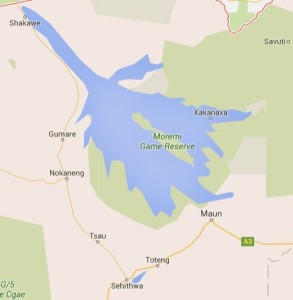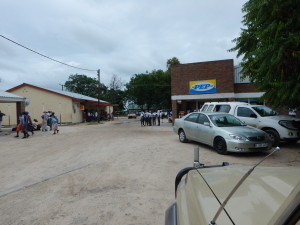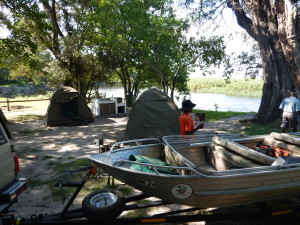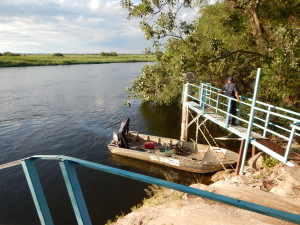We traveled north to Shakawe, in the panhandle of the Okavango, near the Namibian border. Today is the beginning of a nine day sampling trip and my first real foray into the bush proper. This first day was boiling hot. With no AC in the car, I drank 3 liters of water, most of which seems to have leaked out the backs of my knees in the form of sweat.

The road from Maun to Sehithwa to Shakawe is tar, but narrow and pot-holed in places. We passed several road crews redoing the ragged edges of the road. Depending on your grit, you can maintain 100 km/hr, but driving takes focus to avoid the pot holes, donkeys, and herds of goats.
I did not see any wildlife on the trip, partly because this part of Botswana is livestock grazing land and occupied by lots of villages. The wildlife tends to be concentrated more to the east of northern Botswana, where Moremi and Chobe game parks provide wildlife habitat and protection.
The landscape is typical northern Botswana with graceful thorn acacias, shrubby mopane trees, and sandy soils. Everything is green from the rain which means, among other things, that we haven’t encountered the dead and dying livestock we saw two months ago. The land is not exactly flat, but no one would accuse it of being hilly either. It’s more like ripples of vegetated sand dunes that rise and fall to the horizon.
At Gumare, we had a reality check with the drought. There is no tap water in Gumare, which meant no working toilets at the gas station – which meant peeing in the bush. I decided I could wait, given the ready audience hanging out at the gas station.

The plan is to camp tonight in Shakawe, at a campground with the luxuries of hot showers, flush toilets, and a restaurant, all assuming they have water. With the help of a boat, we’ll set nets in the river early tomorrow morning – and hopefully catch some three-spotted tilapia. I expect the river will be deep and broad in this northern part of the panhandle.


After pitching camp at Shakawe, we drove about 30 minutes north to Mohembo at Botswana’s border with Namibia. We went just to see it, and also deploy one of my data loggers to continuously measure conductivity in the river.


The forecast predicts rain every day for our entire 9-day trip, giving us the added challenge of dissecting fish while getting soaked. I’m being over dramatic though because none of my equipment, except my cool “write in the rain” paper and pH meter are water proof, so if it really rains, we’ll have to take a break.
I’m doing my usual sampling – gonad, liver, spleen, and kidney tissues fixed in formalin. We’ll use microscopy later to assess reproductive and metabolic health. I’m also drying muscle and liver samples for heavy metal analysis. The weather is cooler now, so I should be able to measure blood levels of glucose, triglycerides, and cholesterol, assuming my “cardio check” machine doesn’t overheat (or get wet).
After Shakawe, we’ll move south down the panhandle to Sepupa and Guma. Like Shakawe, water quality and quantity at these field sites are routinely sampled by the Okavango Research Institute, so useful historical data exist. After Guma is when the real adventure begins.
That’s when we head into the Delta to areas only accessible by boat. We’ll sample at the confluence of the Jao and Nqoga Rivers, and then south down the Jao. Again, the plan is camping and sampling – but this time without hot showers and restaurants. I’m expecting the wild – but what that exactly means, I don’t know. As long as we catch fish and not crocodiles, we’ll be off to a good start.
